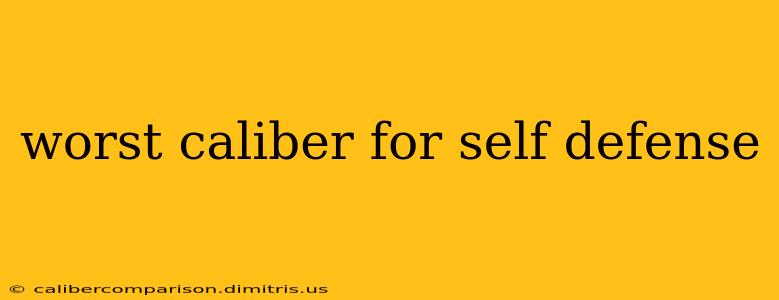Choosing the right caliber for self-defense is crucial. While many factors contribute to effective self-defense (training, situational awareness, etc.), the caliber of your firearm plays a significant role in stopping a threat. This article explores calibers generally considered inadequate for self-defense, focusing on their limitations and why more powerful options are typically preferred. We'll delve into the reasons behind these choices, considering penetration, stopping power, and overall effectiveness.
Understanding the Need for Stopping Power
Before discussing specific calibers, let's establish the primary goal: stopping a threat quickly and effectively. This requires sufficient energy transfer to incapacitate an attacker. Factors influencing this include projectile weight, velocity, and the resulting energy transfer upon impact. A round that fails to quickly neutralize an attacker presents a significant risk to the defender.
Calibers Often Considered Inadequate for Self-Defense
Several calibers are frequently cited as less-than-ideal for self-defense, due primarily to limited stopping power and penetration capabilities. These include:
.22 Long Rifle (.22 LR)
The .22 LR is a popular choice for target practice and small game hunting, but its limitations in self-defense are well-documented. Its relatively low energy transfer often results in insufficient incapacitation, requiring multiple hits to effectively stop a threat. While it offers decent accuracy and manageable recoil, its lack of stopping power makes it a questionable choice for self-defense. The risk of needing multiple shots increases the likelihood of a miss, which could lead to a tragic outcome.
.25 ACP
Similar to the .22 LR, the .25 ACP suffers from significantly low energy and penetration. It's often considered the weakest commonly available self-defense round. The small bullet size and limited energy transfer make it unreliable for quickly stopping an attacker. Its light recoil is appealing to some, but this advantage is heavily outweighed by its lack of effectiveness.
Other Low-Caliber Options
Other low-caliber rounds, such as the .32 ACP, while slightly more powerful than the .25 ACP, still fall short in providing reliable stopping power for self-defense, especially against larger or more determined aggressors. Their performance is often inconsistent, making them a less-than-ideal choice for a situation demanding immediate and reliable incapacitation.
Why More Powerful Calibers Are Preferred
Higher-caliber rounds, such as the 9mm, .40 S&W, .45 ACP, and even larger, offer significantly greater stopping power and penetration. The increased energy transfer leads to a higher likelihood of incapacitating an attacker with fewer shots. While recoil can be more substantial with these calibers, proper training can mitigate this factor. The enhanced ability to stop a threat quickly and decisively far outweighs the slight increase in recoil for most users.
Conclusion: Prioritizing Effectiveness
Choosing a self-defense caliber is a critical decision that should not be taken lightly. While personal preferences and physical limitations play a role, prioritizing a caliber proven to deliver reliable stopping power is paramount. Understanding the limitations of underpowered cartridges is vital to ensuring personal safety. Opting for a caliber with proven effectiveness is a crucial step in responsible self-defense. Remember that firearm proficiency and proper training are essential components of effective self-defense, regardless of the caliber chosen. Always consult with experienced firearm instructors and professionals before making any decisions regarding self-defense weaponry.

